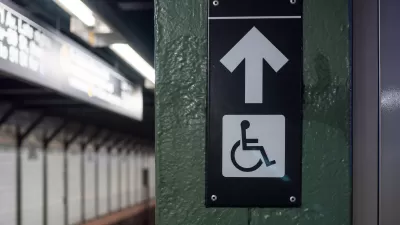Elevator technology developed in the 19th century made the advent of skyscrapers possible. Now that skyscraper construction is rebounding after the recession, can vertical transport systems keep up with developers' and designers' lofty visions?
Tim Catts looks at the latest technologies being developed by the $66 billion elevator industry. "With high-rises in China and Saudi Arabia poised to surpass Dubai’s record 2,717-foot (828-meter) Burj Khalifa, the race to outfit the next generation of super-tall buildings is spurring engineering leaps at Otis, Kone Oyj (KNEBV) and their elevator-making competitors..."
“We’re reinvesting in the skyscraper because the buildings on the drawing board right now are just different,” President Pedro Baranda said in an interview at Otis’s headquarters in Farmington, Connecticut. “Understanding the elevatoring of a very high-rise building can often give you insights into what you can do better at the lower end.”
By utilizing double-deck cars, polyurethane-coated belts, gearless drives, and advanced braking and computerized dispatch systems, elevator companies are pushing the boundaries of what's possible in tall building construction.
“Advances in elevators in the past 20 years are probably the greatest advances we’ve seen in tall buildings,” Council on Tall Buildings and Urban Habitat Chairman Antony Wood said in a telephone interview from Chicago.
FULL STORY: Double-Deck Elevators Rise as Tallest Towers Test Limits

Maui's Vacation Rental Debate Turns Ugly
Verbal attacks, misinformation campaigns and fistfights plague a high-stakes debate to convert thousands of vacation rentals into long-term housing.

Planetizen Federal Action Tracker
A weekly monitor of how Trump’s orders and actions are impacting planners and planning in America.

In Urban Planning, AI Prompting Could be the New Design Thinking
Creativity has long been key to great urban design. What if we see AI as our new creative partner?

King County Supportive Housing Program Offers Hope for Unhoused Residents
The county is taking a ‘Housing First’ approach that prioritizes getting people into housing, then offering wraparound supportive services.

Researchers Use AI to Get Clearer Picture of US Housing
Analysts are using artificial intelligence to supercharge their research by allowing them to comb through data faster. Though these AI tools can be error prone, they save time and housing researchers are optimistic about the future.

Making Shared Micromobility More Inclusive
Cities and shared mobility system operators can do more to include people with disabilities in planning and operations, per a new report.
Urban Design for Planners 1: Software Tools
This six-course series explores essential urban design concepts using open source software and equips planners with the tools they need to participate fully in the urban design process.
Planning for Universal Design
Learn the tools for implementing Universal Design in planning regulations.
planning NEXT
Appalachian Highlands Housing Partners
Mpact (founded as Rail~Volution)
City of Camden Redevelopment Agency
City of Astoria
City of Portland
City of Laramie




























